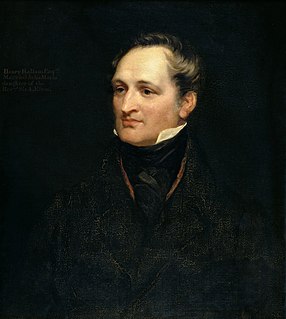Related Research Articles

Sir David BrewsterKH PRSE FRS FSA Scot FSSA MICE was a British scientist, inventor, author, and academic administrator. In science he is principally remembered for his experimental work in physical optics, mostly concerned with the study of the polarization of light and including the discovery of Brewster's angle. He studied the birefringence of crystals under compression and discovered photoelasticity, thereby creating the field of optical mineralogy. For this work, William Whewell dubbed him the "father of modern experimental optics" and "the Johannes Kepler of optics."

Henry Hallam was an English historian. Educated at Eton and Christ Church, Oxford, he practised as a barrister on the Oxford circuit for some years before turning to history. His major works were View of the State of Europe during the Middle Ages (1818), The Constitutional History of England (1827), and Introduction to the Literature of Europe, in the Fifteenth, Sixteenth and Seventeenth Centuries (1837). Although he took no part in politics himself, he was well acquainted with the band of authors and politicians who led the Whig party. In an 1828 review of Constitutional History, Robert Southey claimed that the work was biased in favour of the Whigs.

Penny dreadfuls were cheap popular serial literature produced during the nineteenth century in the United Kingdom. The pejorative term is roughly interchangeable with penny horrible, penny awful, and penny blood. The term typically referred to a story published in weekly parts of 8 to 16 pages, each costing one penny. The subject matter of these stories was typically sensational, focusing on the exploits of detectives, criminals, or supernatural entities. First published in the 1830s, penny dreadfuls featured characters such as Sweeney Todd, Dick Turpin and Varney the Vampire. The Guardian described penny dreadfuls as "Britain’s first taste of mass-produced popular culture for the young."
Leitch Ritchie (1800–1865) was a Scottish novelist and journalist. He was born at Greenock and worked as a clerk in Glasgow, but about 1820 adopted literature as his profession.

Patrick Fraser Tytler FRSE FSA(Scot) was a Scottish advocate and historian. He was described as the "Episcopalian historian of a Presbyterian country".

Francis Egerton, 1st Earl of Ellesmere,, known as Lord Francis Leveson-Gower until 1833, was a British politician, writer, traveller and patron of the arts. Ellesmere Island, a major island in Nunavut, the Canadian Arctic, was named after him.
Henry Colburn was a British publisher.

James Lackington was a bookseller who is credited with revolutionizing the British book trade. A shoemaker's son trained as a cobbler, he showed early initiative by selling pies and cakes in the street when aged 10 and teaching himself to read. In August 1773, Lackington arrived in London with two shillings and sixpence, and would eventually become a wealthy man. He is best known for refusing credit at his shop which allowed him to reduce the price of books throughout his store. He printed catalogues of his stock; according to Lackington's biography, the first edition contained 12,000 titles. He bought whole libraries and published writers' manuscripts. He also saved remaindered books from destruction and resold them at bargain prices, firmly believing that books were the key to knowledge, reason and happiness and that everyone, no matter their economic background, social class or gender, had the right to access books at cheap prices.

Sir Edward Cust, 1st Baronet, KCH was a British soldier, politician and courtier.
Charles Henry Timperley was an English printer and writer.
Egerton Smith was a Liverpool publisher, founder of the Liverpool Mercury.
The Cheap Magazine, subtitled "The Poor Man's Fireside Companion", was a fourpenny Haddington monthly published from 1813 to 1815 by George Miller (1771–1835), an East Lothian printer. As "one of the first attempts to diffuse a pure and useful literature among the less educated portion of Scotland", this effort foreshadowed later publications such as Chambers's Edinburgh Journal and the Penny Magazine. Yet a cheap price required a large circulation, and Miller's attempt to sustain a large readership without taking any definite religious position ended in financial failure.
Christian Isobel Johnstone (1781–1857) was a prolific journalist and author in Scotland in the nineteenth century. She was a significant early feminist and an advocate of other liberal causes in her era. She wrote anonymously, and under the pseudonym Margaret Dods.

James Allanson Picton was a British independent minister, author, philosopher and Liberal politician. Picton promoted a philosophy known as Christian pantheism.
John Watkins was an English miscellaneous writer, known as a biographer. He is most famous for being the author of An Universal Biographical and Historical Dictionary.
The British Journal of Photography (BJP) is a magazine about photography, publishing in-depth articles, profiles of photographers, analyses, and technological reviews.
Critical and Miscellaneous Essays (1838-1839) is the title of a collection of reprinted reviews and other magazine pieces by the Scottish philosopher and historian Thomas Carlyle. Along with Sartor Resartus and The French Revolution it was one of the books that made his name. Its subject matter ranges from literary criticism to biography, history and social commentary. These essays have been described as "Intriguing in their own right as specimens of graphic and original nonfiction prose…indispensable for understanding the development of Carlyle's mind and literary career", and the scholar Angus Ross has noted that the review-form displays in the highest degree Carlyle's "discursiveness, allusiveness, argumentativeness, and his sense of playing the prophet's part."
Joseph Harrison was a British horticulturalist and editor of horticultural periodicals.
References
- 1 2 Timperley 1839
- ↑ Picton 1879. Timperley 1839, however, reports the magazine as initially priced at 3d.
- ↑ Anonymous 1859 , p. 327
- ↑ Picton 1879
- ↑ Anonymous 1859 , p. 328
Bibliography
- Anonymous (April 1859). "Cheap Literature". British Quarterly Review. 29: 313–45.
- Picton, J. A. (1879). "The"Kaleidoscope," a liverpool magazine". Notes and Queries (289): 32. doi:10.1093/nq/s5-XII.289.32a.
- Timperley, Charles Henry (1839). A Dictionary of Printers and Printing. p. 868.